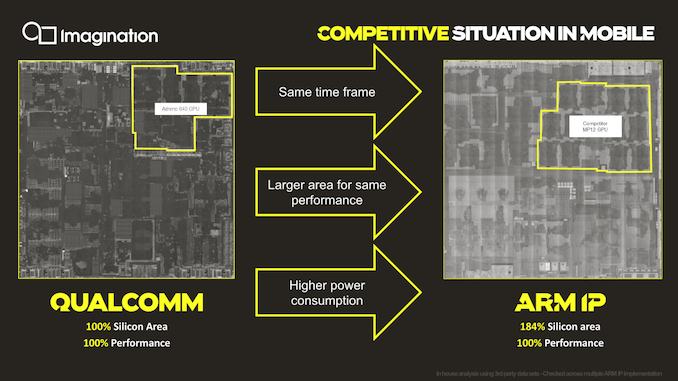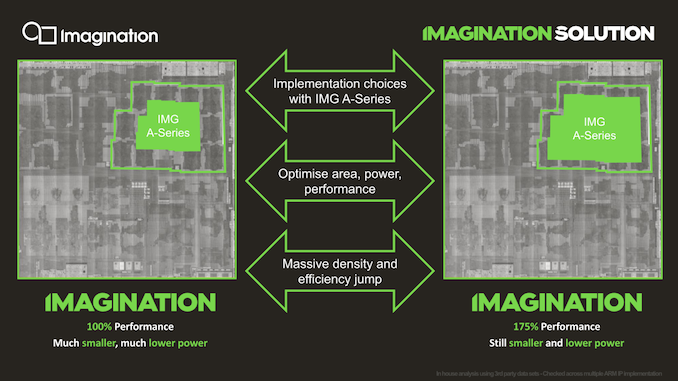Imagination Announces A-Series GPU Architecture: "Most Important Launch in 15 Years"
by Andrei Frumusanu on December 2, 2019 8:00 PM ESTPPA Projections - Significant, If Delivered
Moving on, the A-Series improvements don’t mean much if we can’t put them into context in the competitive landscape.
As mentioned in the introduction, Imagination seem aware of the current PPA deficit that GPU vendor IP offers versus custom designs by more vertically integrated SoC vendors.
Starting off with a comparison between current generation Qualcomm GPU against an Arm GPU. Imagination didn’t specifically mention which designs we’re talking about here, but we do clearly see from the die shots that the SoCs being compared are the Snapdragon 855 and the Exynos 9820.
Here Imagination describes that for a similar performance level, Arm’s Mali GPUs are using ~184% the silicon area compared to Qualcomm’s Adreno implementation.
I do have some doubts about the validity of the comparison being made here, as these SoCs were not made on the same process node – Qualcomm's design is built on TSMC's denser 7nm process, while Samsung's Exynos uses their larger 8nm process. With that in mind, we take the metrics presented with a huge grain of salt as Imagination does say the figures are based on analysis of multiple Arm IP implementations rather than a single data-point.
Projecting the A-Series against a current Mali-G76 implementation, targeting a performance level equivalent to current generation flagship implementations (~100fps in Manhattan 3.0), an A-Series GPU would achieve a significantly smaller GPU implementation requiring much less die area. The comparison implementation here would be an AXT-16-512 implementation running at slightly lower than nominal clock and voltage (in order to match the performance).
If a customer were to choose to use more die area to go wider and slower in clock (more efficient), while still maintaining an estimated area that would be smaller than a Mali GPU, it would roughly achieve a 75% performance advantage. The comparison here would be an AXT-32-1024 running quite far below nominal, giving it a large power efficiency advantage.
Of course, Imagination’s comparison here were made against the current generation Qualcomm and Arm GPUs, which aren't what it'll actually be competing against. Instead, by the time A-series SoCs ship, it will be competing against the next-generation Adreno as well as Mali-G77. We know Arm’s promised goals for the G77 and the improvements in performance per mm² and performance perf/W is around 1.2-1.4x, which we could generalize to 1.3x. Samsung’s upcoming Exynos 990 only promises a 20% performance increase, which is slightly below this projection. On the Qualcomm side and the upcoming Adreno generation, we’ll have to wait a few more days to be able to talk about details, but generally we expect improvements in the same ballpark.
Fortunately for Imagination, the projected PPA figures and advantages for the A-Series are high enough that they would still be notably ahead of both Qualcomm and Arm’s upcoming next generation GPUs, keeping a comfortable lead in either GPU area, or performance, depending on the configuration.
So far everything looks quite splendid – what remains to be seen if Imagination and their licensees are able to deliver on the projected figures.












143 Comments
View All Comments
ET - Tuesday, December 3, 2019 - link
> I fear that this will be a very niche product unless it absolutely dominates all other solutions.At least from the description in the article, it seems to dominate Mali. Even next gen Mali. I don't expect Apple or Qualcomm to move. Samsung I think would be flexible. It's impossible to say how well RDNA fits all price points or when it will arrive, so ImgTech could find a place there. And with the A series supposedly much better than Mali in performance per silicon, I don't think that HiSilicon using it is totally out of the question.
Spunjji - Tuesday, December 3, 2019 - link
No reason HiSilicon can't change their minds if there's a compelling reason. PPA advantages directly translate into cost savings, which is very compelling indeed.MediaTek are probably going to be the biggest customer, though.
mode_13h - Wednesday, December 4, 2019 - link
Chinese want nothing to do with ARM, any more. Got it?So, anyone who's using Mali, or any Chinese phone makers who are using Qualcomm are potential customers.
vladx - Wednesday, December 4, 2019 - link
If you bothered to read the article, you would've found the answer but I guess Americans can't be bothered to read.s.yu - Wednesday, December 4, 2019 - link
"Americans can't be bothered to read"Wow, calling others haters, and look at you.
Etain05 - Tuesday, December 3, 2019 - link
I know that they don’t actually compete, since Apple will never offer its design for licensing, but I still think it’s interesting to compare them.Let’s take the numbers from the Huawei Mate 30 Pro review and compare making some assumptions.
Andrei says: “The comparison implementation here would be an AXT-16-512 implementation running at slightly lower than nominal clock and voltage (in order to match the performance).”
Let’s assume the AXT-16-512 is underclocked by 10% to get to the same performance as the Exynos 9820 and Snapdragon 855. Let’s also assume that an AXT-32-1024 is exactly double the performance of the AXT-16-512.
So, a nominally clocked AXT-16-512 would have 110% the performance of the Snapdragon 855 and Exynos 9820. Double that, and you get 220% the performance, for the AXT-32-1024.
Looking at the Huawei review, here are the numbers:
GFXBench Aztec Ruins High
Exynos 9820 and Snapdragon 855: ~16fps —> AXT-32-1024: 16fps + 120% = 35,2fps
Apple A13: 34fps
GFXBench Aztec Ruins Normal
Exynos 9820 and Snapdragon 855: ~40fps —> AXT-32-1024: 40fps + 120% = 88fps
Apple A13: 91fps
GFXBench Manhattan 3.1
Exynos 9820 and Snapdragon 855: ~69,5fps —> AXT-32-1024: 69,5fps + 120% = 153fps
Apple A13: 123,5fps
GFXBench T-Rex
Exynos 9820 and Snapdragon 855: ~167fps —> AXT-32-1024: 167fps + 120% = 367fps
Apple A13: 329fps
It seems that at least on performance (with generous assumptions), if the new architecture fulfils all promises, it would be competitive, even slightly better than the Apple A13. The problem is that it won’t compete with the A13, but the A14...
How did we get to Apple dominating GPUs too, so fast?
drexnx - Tuesday, December 3, 2019 - link
they're totally unafraid to spend as much die space as they need to get their performance scaling. look at a history of Ax die sizes and you'll see they're all over the placeSpunjji - Tuesday, December 3, 2019 - link
Agreed. It's their vertical integration at work - they're the only company prepared to spend that much die area on performance because they're the only company besides Samsung that can guarantee to sell all every chip they make in a high-end, high-margin device.Andrei Frumusanu - Tuesday, December 3, 2019 - link
Apple's GPUs are the second smallest in the space - only Qualcomm uses less die area.vladx - Wednesday, December 4, 2019 - link
When you extort your customers like Apple does, you can afford to design more expensive SoCs while still keeping huge profits.Apple is the biggest example of what a toxic system capitalism can become.